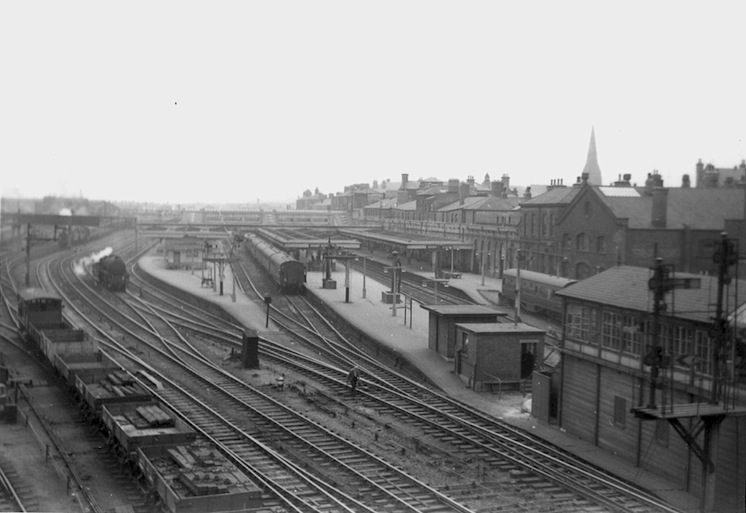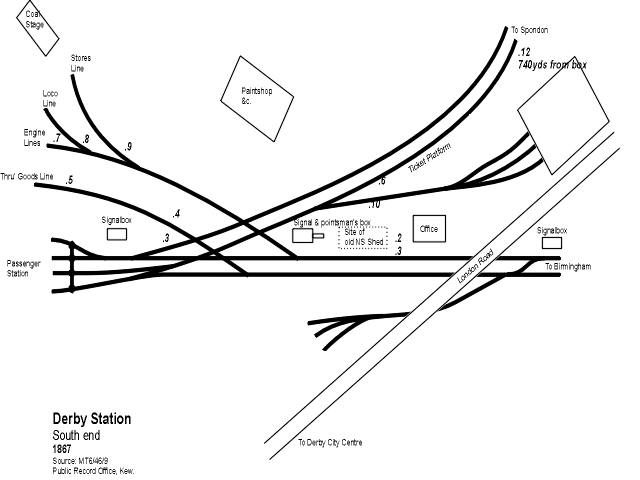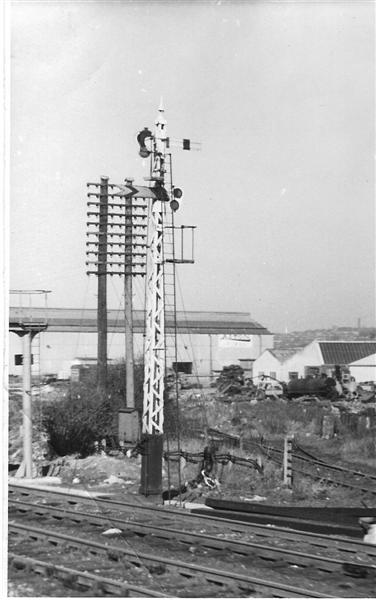
DERBY AREA SIGNALLING
SIGNALLING AROUND DERBY STATION
The signal box type numbers referred to in this article refer to the designs defined in the book The Signal Box, by the Signalling Study Group, and the is a page elsewhere on this site which details this system of classification.

Derby station was built in 1839 on land south east of the town known as The Castlefields. The original station, known as the ‘Tri-junc Station’, had just one platform, albeit quite long at 1,050 feet and configured with three usable faces. There were a total of eight through lines in the original layout, all inter-linked by small wagon turntables.
The first junction at Derby was — and still is — called Derby Junction. It was here that the Midland Counties line from Nottingham which opened on 30th May 1839 joined the North Midland railway to Masborough opening on 11th May 1840. The joint station was located just south of this junction with a bridge over the River Derwent between. The Midland Railway was formed on 10th May 1844 as an amalgamation of these two companies and the Birmingham & Derby Junction Railway, whose line joined the others end-on in the station.
Of course at this time there would have been no fixed signalling. Instead pointsmen would be responsible for physically controlling trains at the direction of a policeman.
We are lucky that early in the twentieth century a chap named George Pratt, an employee of the Midland Railway for many years, published some of his memories of those early days. He described these pointsmen as having an alcove at the north end of the station near the Cheese Warehouse
. They apparently made a fine sight as they signalled trains in and out of the station with a shiny top hat and flowing flag
. The same account describes a semaphore signal at the end of the station building with an enormous arm, twice or thrice the size of the present signal arms, which, when it dropped, it went down with a great bang
.
Signalling in the traditional sense in Derby begins – and ends as that is where the power box is now located – at London Road Junction south of the station. It is here that the Midland Railway is reputed to have built its first “traditional” signalbox although earlier structures existed, most notably at Clay Cross Junction. The south end of the station was of much lesser importance at first as the line in from Spondon was only opened on 27th June 1867 allowing trains from Nottingham and London to gain access to the south end of the station for the first time. Prior to this ‘London Road Junction’ served only the Derby Yard and the locomotive works.
When Maj. Hutchinson, the Inspecting Officer for the Board of Trade, inspected the new layout at the south end of the station was somewhat critical. His report dated 30th May 1867 stated; The signal arrangements at Derby Station are incomplete. Signals marked 5, 7, 8 & 9 on the tracing enclosed should be interlocked with the branch points and signals. Gongs are required in the main signal box for communicating with the two intermediate [?] boxes.

The signals listed in Maj. Hutchinson’s report are thus:
This table illustrates that although this was the centre of the Midland Railway empire, there were interlopers. The North Staffordshire Railway had running powers into the station and the Midland’s great rivals, the London & North Western Railway also had running powers – eventually – from Wichnor Junction into their own goods yard south of the station.
The period of 1867 – 1869 saw a great deal of work carried out in the area around the station. A second and third platform were taken into use at Derby station around 1867 and sometime around this period Derby Station signal box was opened midway along the new platform. Signal boxes were being constructed or replaced at London Road Junction, Bell Box Junction, Derby Junction and Derby North Junction. This work coincided with block telegraph working being introduced between London Road Junction and Melbourne Junction on the Birmingham line. Block working northwards was introduced by 1873.
Although the actual structures changed, the pattern and location of signalling around Derby station changed little in the following 100 or so years during which it was manually signalled.

In 1877 the structure at Bell Box Junction was renewed and renamed Derby Station North Junction. The new box was, presumably, enlarged as this was something that the Midland Railway had to do quite regularly toward the end of the Nineteenth Century. It was about this time that the Board of Trade were pressing railway companies to provide interlocking between signals and points on passenger lines.
London Road junction was also renewed in 1877 and a new signal box was opened at Gas Works Crossing on the Spondon branch. This box was very short lived being abolished between April 1878 and February 1879 at which time a new box called Way and Works was opened on the Down side of the Spondon line.
As the station expanded with three additional platform faces taken into use in July 1881, further signal boxes were added. The first was to control the goods lines and access to the Loco Works to the east of the station and was called Engine Sidings. On 6th July 1881 the signalling in the station itself was renewed. The box on Platform 2 was renewed with a non standard structure which became Derby Station ‘A’ which was an architectural gem (see The Signal box plate 97). A second box – Derby Station ‘B’ was opened on platform 4, slightly further to the north than its counterpart. Both boxes controlled scissors crossings which were designed to allow platform faces to be used by more than one train.
The last mechanical box to be opened on a new site around Derby station was a Midland Type 2a box called Engine Sidings No. 2 which was opened at the south-east corner of the station on 23rd March 1890 and was to out-live every other box in the area. Engine Sidings became Engine Sidings No.1 on the same day. The same year saw Way & Works box being renewed on 15th June.
Autumn 1892 saw another series of layout changes and signalbox renewals. On 25th September that year Derby North Junction box was renewed followed on 9th October by Derby Junction and Derby Station North Junction. The layout changes weren’t complete until 18th December that year with the goods lines being used temporarily as the passenger lines. On that date a renewed Engine Sidings No.1 opened.
The 1890 Way & Works box was replaced with a fourth structure on the site on 2nd April 1905. This new box contained a 48 miniature lever Siemens & Halske electro-pneumatic frame. Relatively little is known about this unique experiment on the part of the Midland Railway. However, in 1908 the company's Telegraph Superintendent's Department produced a breakdown of the costs involved in operating this frame. Based on 1¼ pence per unit of current, and an estimated 5,000 lever movements per weekday (1,500 on Sundays), the cost per lever movement was 0.00496 of a penny. More crucially, maintenance was costed at 0.0117 of penny per lever movement. Overall, the operating cost of the frame over six months was £40 3/6. In terms of the operation of this frame, we know a little thanks to a Board of Trade report into an accident on 30th March 1923 which, although it occurred at London Road Junction, centred largely on the working of Way and Works box. Though not really the fault of the box, this accident in fog was blamed largely on the slack working of the signalmen at Way & Works where, evidently, it was practice to pull off the down outer home immediately on accepting a train from Spondon Junction, regardless of whether or not the train would be held prior to London Road Junction accepting it.
Derby Station ‘B’ suffered the ignominy of being the first box in the station area to be abolished. That occurred on 31st December 1922 and thus the last act of the Midland Railway. Derby Station ‘A’ and was to last until after the Second World War. Indeed most of the structures erected by the MR during the 1890’s were to survive much longer than their predecessors.
Of the early – Type 1 – boxes around Derby Station, only the 1877 London Road Junction box lasted into the Twentieth Century. It succumbed on 6th December 1925 but survived long enough to be captured on film. Although opened by the LMS, the new London Road Junction box was a Midland Type 4d which means that although they had gone back to using the six paned windows, as a legacy of First World War economies, it was bereft of finials and decorative features. The new box had an 83 lever 4½” LMS frame – although as this was numbered 1 to 81 with A & B at the low numbered end, there were probably many changes during its time.
Way and Works box was reframed with a slightly more conventional 40 lever REC tappet frame with 4½” centres on 23rd January 1932. This frame was housed at the back of the box despite the structure obviously being built for a front frame – one wonders how many banged shins there were as people walked through the door over the years?
It wasn’t until the BR era that any further changes took place. Derby Station ‘A’ was rebuilt along with the station in 1952. It was replaced with what was unkindly described as a “cupboard under the stairs”. That is a shame as this “box” is the only one which survives today – in use as the station manager’s office which is more in keeping with its anonymous design. Curiously, the new box kept its ‘A’ appellation. Being a “modern” box in the new station, Derby Station ‘A’ was furnished with a block shelf almost resembling a panel in a modern powerbox. All the signal & point repeaters as well as the block instruments were built into the shelf which was finished with a white enamel surface.
Around the time the station was rebuilt, London Road Junction and Derby Junction acquired large enamelled signs on their fronts announcing their proximity to “Derby Midland”.
The last mechanical box to be renewed in the area around Derby station was Derby North Junction on 30th July 1957 when a new BR (LMR) Type 15 box was opened with a second-hand REC frame of 55 levers.
A signal unique to Derby

This photograph recently came to my notice. It shows one of a number of experiments the Midland Railway carried out close to the signal works in an attempt to economise in materials for their signals. This particular experiment involves a timber lattice construction and was used on the goods lines at Derby North Junction. The home signal, worked by lever 44 in Derby North box, protected the Derby Corporation Ground Frame on the Up Goods, whilst the distant arm is St. Mary's Junction Down Distant.
The photograph has been taken from the Up platform of Nottingham Road station and the yet-to-be-commissioned DY155 is seen in the background.
The historical significance of the signal post was recognised when it was abolished in 1969, and it was secured for preservation. Though now unfortunately snapped in two, the post is inside the Butterley organisation's museum at Swanwick Junction.
At least one experimental Midland Railway signal post still existed into the Network Rail era: Fiskerton Station's Down Home (FS5) was a round wooden post - for many years a unique survivor, it was felled c.2007. Given that the Up Distant is still a Midland Square Post (a lot more common at one time, but now almost all gone), Fiskerton is still quite an historic site!
The end – almost – of mechanical signalling in the Derby area came on 12th July 1969 with the commissioning of phase three of the Derby Powerbox scheme. This resulted in the abolition of all the mechanical boxes around the station with the exception of Engine Sidings No.2. This box held on until 8th February 1987 as a shunt frame controlling access to the Motive Power Depot (known locally as “Four Shed’), the Loco Works and the stabling sidings in front of the Powerbox. It also released a ground frame named Engine Sidings No.1, after the box which once occupied the site, and which still exists today.

This diagram of Way & Works from the collection of Derby Museum, held in the Midland Railway Study Centre dates from 1968 and includes some of the stage work in preparation for the Power Box. Notably, the crossover road has been reversed to facilitate easier access into then new Research Sidings. However, it wasn't until 1990 that mainline facing moves were allowed with bi-directional working over the up main line.
Virtually nothing is left today as a reminder of mechanical signalling. The perverse exception to this is a derelict “privy” dating from 1952 which once served the signalmen of London Road Junction. This survivor will doubtless soon be swept away too as significant remodelling of the layout south of Derby station is promised in connection with electrification.
Signal box designs referred to in the text
Dave Harris, Willington, Derby, UK.
Email: dave@derby-signalling.org.uk
Page last updated: Monday, 31 August 2015